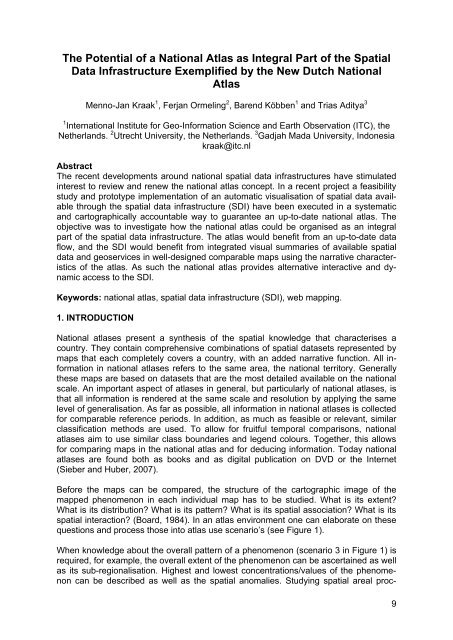SDI Convergence - Global Spatial Data Infrastructure Association
SDI Convergence - Global Spatial Data Infrastructure Association
SDI Convergence - Global Spatial Data Infrastructure Association
Create successful ePaper yourself
Turn your PDF publications into a flip-book with our unique Google optimized e-Paper software.
The Potential of a National Atlas as Integral Part of the <strong>Spatial</strong><br />
<strong>Data</strong> <strong>Infrastructure</strong> Exemplified by the New Dutch National<br />
Atlas<br />
Menno-Jan Kraak 1 , Ferjan Ormeling 2 , Barend Köbben 1 and Trias Aditya 3<br />
1 International Institute for Geo-Information Science and Earth Observation (ITC), the<br />
Netherlands. 2 Utrecht University, the Netherlands. 3 Gadjah Mada University, Indonesia<br />
kraak@itc.nl<br />
Abstract<br />
The recent developments around national spatial data infrastructures have stimulated<br />
interest to review and renew the national atlas concept. In a recent project a feasibility<br />
study and prototype implementation of an automatic visualisation of spatial data available<br />
through the spatial data infrastructure (<strong>SDI</strong>) have been executed in a systematic<br />
and cartographically accountable way to guarantee an up-to-date national atlas. The<br />
objective was to investigate how the national atlas could be organised as an integral<br />
part of the spatial data infrastructure. The atlas would benefit from an up-to-date data<br />
flow, and the <strong>SDI</strong> would benefit from integrated visual summaries of available spatial<br />
data and geoservices in well-designed comparable maps using the narrative characteristics<br />
of the atlas. As such the national atlas provides alternative interactive and dynamic<br />
access to the <strong>SDI</strong>.<br />
Keywords: national atlas, spatial data infrastructure (<strong>SDI</strong>), web mapping.<br />
1. INTRODUCTION<br />
National atlases present a synthesis of the spatial knowledge that characterises a<br />
country. They contain comprehensive combinations of spatial datasets represented by<br />
maps that each completely covers a country, with an added narrative function. All information<br />
in national atlases refers to the same area, the national territory. Generally<br />
these maps are based on datasets that are the most detailed available on the national<br />
scale. An important aspect of atlases in general, but particularly of national atlases, is<br />
that all information is rendered at the same scale and resolution by applying the same<br />
level of generalisation. As far as possible, all information in national atlases is collected<br />
for comparable reference periods. In addition, as much as feasible or relevant, similar<br />
classification methods are used. To allow for fruitful temporal comparisons, national<br />
atlases aim to use similar class boundaries and legend colours. Together, this allows<br />
for comparing maps in the national atlas and for deducing information. Today national<br />
atlases are found both as books and as digital publication on DVD or the Internet<br />
(Sieber and Huber, 2007).<br />
Before the maps can be compared, the structure of the cartographic image of the<br />
mapped phenomenon in each individual map has to be studied. What is its extent?<br />
What is its distribution? What is its pattern? What is its spatial association? What is its<br />
spatial interaction? (Board, 1984). In an atlas environment one can elaborate on these<br />
questions and process those into atlas use scenario’s (see Figure 1).<br />
When knowledge about the overall pattern of a phenomenon (scenario 3 in Figure 1) is<br />
required, for example, the overall extent of the phenomenon can be ascertained as well<br />
as its sub-regionalisation. Highest and lowest concentrations/values of the phenomenon<br />
can be described as well as the spatial anomalies. Studying spatial areal proc-<br />
9

















